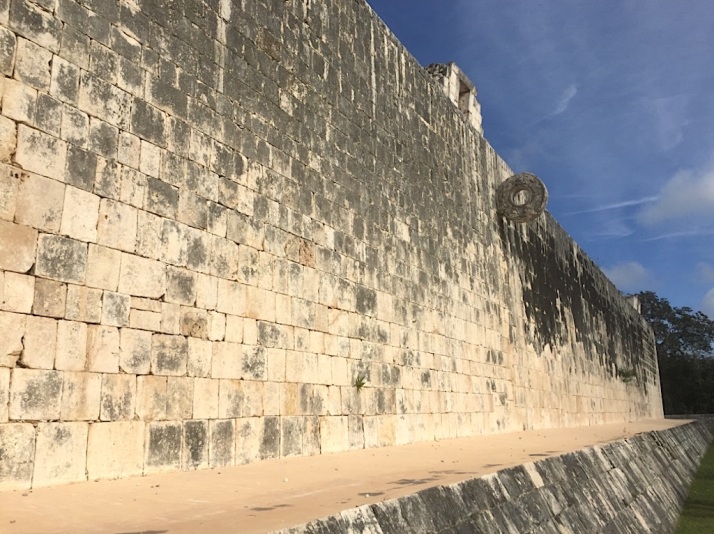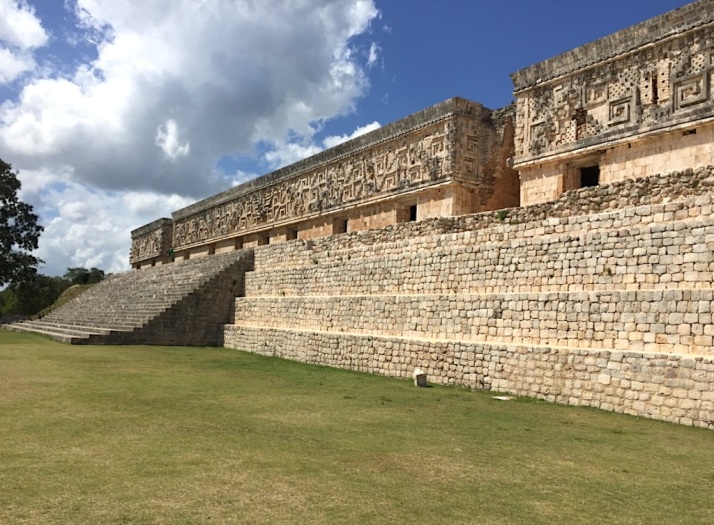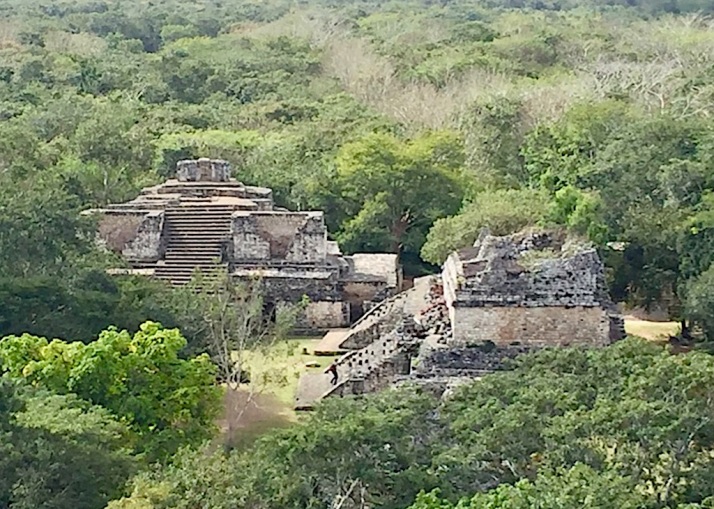It is a mystery why the great Mayan civilization, with its comprehensive calendar, and advanced knowledge of mathematics and astronomy, would abruptly scatter and retreat into the thick and knotted jungle. To try to disentangle this paradox, we visited the three most popular Mayan ruins on the Yucatán Peninsula at Chichén Itzá, Uxmal, and Tulum.

The rain god Chaac and his oversized schnoz, Chichén Itzá
Chichén Itzá is the largest and most visited archeological site on the Yucatán Peninsula. It was established in 300 AD, flourished between 800 and 925 AD, and is now recognized as a UNESCO World Heritage Site and one of the New Seven Wonders of the World.

El Castillo, (Pyramid of Kukulcán), Chichén Itzá
The well-preserved structures on the site reveal the Maya understanding of calendars and mathematics. The iconic centerpiece, El Castillo (Pyramid of Kukulcán), is a giant calendar rendered in stone. The 91 stairs on each of its four sides plus the top level adds up to 365, one step for each day of the year.

El Caracol Obervatory, Chichén Itza
At Chichén Itzá, the Maya expanded their knowledge to astronomy and its connection to the seasons. The circular domed tower El Caracol looks like a modern observatory with roof slits aligned with points of astronomical significance. Even though they excelled at science, the Maya also followed strong religious traditions.

Skull Rack (Tzompantli), Chichén Itzá
To appease their gods, especially Chaac the god of rain, the Maya faithfully practiced human sacrifice. The bodies of the sacrificed where thrown into their sacred cenote (deep freshwater sinkhole), considered a portal to the underworld. The skulls were displayed in a nearby rack platform called a Tzompantli.

Ball Court, Chichén Itzá
The Maya also played a brutal ball game where both teams lost. Shaped like a large capital letter “I” with target rings on both sides, the 300-foot (90 m) long court at Chichén Itzá is the largest in the Mayan world. Panels depicting the game show one player holding a knife and the severed head of his opponent. Archeologists poignantly postulate that it was the winning team that lost their scalps.

Pyramid of the Magician, Uxmal
Moving on to Uxmal, the Mayans demonstrated their finest architectural skills in the decorated Puuc style. A prime example is the steeply-angled Pyramid of the Magician (Adivino), a remarkable Mexican pyramid, constructed on a uniquely oval base.

Palacio del Gobernador (Governor’s Palace), Uxmal
What is most appealing at Uxmal is the meticulous ornamentation on the ancient buildings. The Palacio del Gobernador, called “Mesoamerican architecture’s finest moment”, includes a broad band of mosaic Chaac adornments alternating with highly stylized snakes.

Temple to the Wind God, Tulum
The splendor of the structures at Uxmal is stunning, but the coastal location of Tulum is downright magnificent. Perched on a cliff overlooking a white sand beach on the blue-green Caribbean Sea, a visit to Tulum is all about beating the crowds to get the best photographs.

The Castle, Tulum
Rising early, we were third in line when the site opened. Like Black Friday shoppers, we hustled through the cliff-side site to the best camera angles. After an hour of relatively undisturbed scenery, we exited the site to find an arriving stream of unloading tour busses.

We also visited Ek Balam, another Mayan site surrounded in jungle
After visiting the three most famous Mayan sites on the Yucatán Peninsula, we still can’t decide if natural or political factors caused the sudden disappearance of their civilization. More clues might still be hidden in their architecture, in the unexplored ruins of the deep jungle, or in the faces of the Maya people of modern-day Yucatán.

Waiting for the bus in Tulum
Blogger’s Note: After our month-long, 750 mile (1,200 km) circumnavigation of the Yucatán Peninsula, Esther has returned home to Reno, Nevada to attend to some business, while I have continued on to the southern Mexican city of Oaxaca for the month of March. In three weeks, Esther will be rejoining me in Oaxaca to continue together on our month-at-a-time adventure.
Featured Image: A Mayan Arch and Pyramid of the Magician, Uxmal

The weird thing is the Mayan civilization seems to have arrived from nowhere and Mayan DNA isn’t found anywhere else in the Americas …
LikeLiked by 2 people
That is very weird and interesting. Sometimes, DNA analysis creates a lot more questions than answers. Perhaps earlier discrete Proto-Mayan people lived hidden lives deep in the jungle, only to emerge once their population grew large enough to interconnect and organize? I also read that the Maya were one of only two civilizations (Sumerians) to create a written language from scratch without exposure to an existing language as a guide. Those Mayans sure are mysterious.
LikeLiked by 3 people
Rumour has it that they emigrated from Venus.
LikeLiked by 2 people
It was a friend talking about how the Myans were ‘spooky’ that got me interested in heading over to this part of the world. Even though I am yet to make it to Mexico and I’m pretty settled in Chile for the moment there is still plenty of time and much more travel to investigate the mystery for myself.
LikeLiked by 1 person
Hello Danielle, Thanks for checking out my post and for letting me know your thoughts. I hope you have the chance to investigate the Mayan mystery for yourself, and I look forward to hearing your theories.
LikeLiked by 1 person
Wonderful photographs! I do wonder what happened? Do you think we will ever know?
LikeLiked by 2 people
Thank you, Ann. I think that the use of technology will eventually answer these questions. Recent radar surveys have identified hundreds of thousands of new structures previously hidden in the jungle. Scientists now think that there were at least 20 million people living in the ancient Mayan world. This overpopulation probably led to deforestation and a severe undersupply of natural resources. With all of these new sites to explore, we are bound to solve the mystery.
LikeLiked by 2 people
I really hope we do. If nothing else, to make sure we don’t repeat the mistakes!
LikeLiked by 1 person
It looked like a fascinating trip through the Yucatan and perhaps the mysteries have awakened a new line of research for you. Regardless, the sites are fascinating and provocative. We also enjoyed Tulum early in the morning and the coastal setting is magnificent. Coba was impressive but it rained very hard the day we were there so that curbed our enthusiasm a bit. Thanks for sharing the visual journey and enjoy Oaxaca.
LikeLiked by 1 person
I shudder to think of visiting Tulum mid-day with all of the tour groups. Coba was on my list, but we just ran out of time. Like all great destinations, no matter how long you stay, you can’t do everything, and must leave some things for another visit. The archeology of Mesoamerica is definitely a new interest for me. It was interesting to see some of the Central Highlands influences at the Mayan sites, and the news of vast numbers of newly-discovered Mayan structures should be fun to follow. All the best to you guys!
LikeLiked by 1 person
So many people vanished without a trace. And what stands tall and majestic are the structures built by those people. Now those structures are helping us trace the history of their makers.
Beautiful pictures. It captures the mystery and the majestic history of the place.
LikeLiked by 1 person
You are so right, Deepa. The sites we visited were cleared, marked with interpretative signs, and crawling with visitors and vendors. What I would love to do is hack my way through the jungle with a machete to find and explore the unknown sites. There is still so much that we don’t know.
LikeLiked by 1 person
We are all on an endless exploration. So true.. there is still so so so much that we don’t know. And that is the beauty i guess. The journey is so beautiful that I really wish that there is always somethings that are unknown and unexplored so that we can keep exploring. Happy exploring Joe.
LikeLiked by 1 person
Joe, for my money, the cities failed because of climate change and a number of successive, long-term droughts. As you know, the water table in the Yucatán is relatively deep and they depended on aquifers for water. There are actually very few rivers on the surface in the Yucatán and the porous limestone drains away most of the rainy season rains, making the area quite arid. The sisterns they built helped but without rain it was only a matter of time. Any ideas? ~James
LikeLiked by 2 people
You are probably right, James. I have read that the drought was also exacerbated by their slash-and-burn farming methods and resulting severe deforestation. It became a vicious cycle that led to starvation of the working class, who probably also became more susceptible to disease and likely revolted against their rulers. It seems that the bottom just fell out. What an incredible time that must have been. Thank you for the insightful comment and for sharing your opinions on this fascinating subject. Joe
LikeLike
Joe, Michael Coe’s book “The Maya” (latest edition) was an informative read and is up to date on all the latest discoveries and ideas. With Lidar etc. the pace of discovery on the Maya has accelerated tremendously. And you’ll be glad to hear Amazon has the ebook. ~James
LikeLiked by 1 person
James, I appreciate you making me aware of this author and important book. Since the subject of the mysterious Maya is fairly new to me, I think that this book will fill a lot of gaps in my understanding, especially now that I have had the chance to visit a few of the most famous sites. Joe
LikeLike
Fantastic photos! I’ve read a little about the Mayans but had no idea their sites were so well preserved. Looks like a beautiful area as well.
Have to wonder, how in the world did they keep their sports program going, giving their “winner takes all, winner gives all” mentality? 😳
LikeLiked by 1 person
Thanks, Christi. We only visited the popular and famous Mayan sites, which are very well preserved and maintained. There are thousands of other sites that are covered in jungle. Good point about their sports program. I don’t know; maybe Mayan jocks weren’t very smart?
LikeLiked by 1 person
I will be visiting this area with my husband and my daughter in July. The Mayan ruins are on my list of places to visit. We will be based at Playa del Carmen, do you reccomend visiting the sites independently or guided tours? Just found your blog and enjoying catching up with your posts😄
LikeLiked by 1 person
Hi Gilda, Playa del Carmen is a beautiful and convenient base for exploring the Yucatán beaches, culture, and archeological sites. Regarding guided tours, my preference is to read about a site ahead of time and explore it on my own. I like to take my time, walk the entire site, and look around the edges for its less popular aspects. I will hire a guide or join a tour group if I haven’t done my research, and have a lot of questions to ask. Thank you for your interest in our blog, and happy travels to you and your family!
LikeLiked by 1 person
I visited Uxmal in January. What a wonderful experience it was to climb the Mayan ruins!
LikeLiked by 1 person
Hi Amy, Of all the Mayan sites in the Yucatán, I was most excited to visit Uxmal. The site, with its intricate detail, well-preserved structures, and relatively small crowds was much better than I even anticipated. Simply unforgettable!
LikeLiked by 1 person